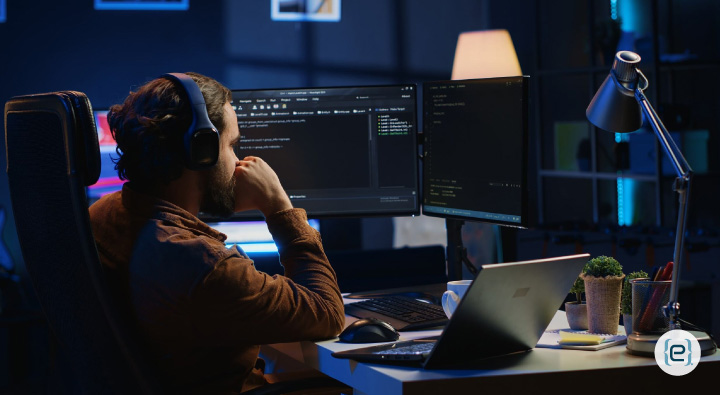The Great Screen Debate: How Many Monitors Do You Really Need?


Last week, I walked into my coworker’s office and nearly burst out laughing—he had EIGHT monitors lined up like a NASA command center. It made me reflect on my journey from a single laptop screen to my current setup, and all the lessons I’ve learned along the way. If you’re considering a screen upgrade, let’s talk honestly about what you really need for your workflow, your eyes, and your neck.
Key Factors When Choosing Your Screen Setup
Your ideal monitor configuration depends on several factors:
- Work Type: Are you coding, designing, analyzing data, or just answering emails?
- Desk Space: How much room do you actually have?
- Focus Needs: Does more screen real estate help or hurt your concentration?
- Task Switching Frequency: Are you juggling between apps or mostly focused on one?
- Eye Strain Management: More screens mean more blue light and potential fatigue.
- Workflow Efficiency: Is your setup making you faster, or just busier?
- Budget Constraints: Quality monitors, arms, and hardware add up quickly.
- Hardware Limits: Can your laptop or desktop actually support all those screens?
- Neck Comfort: Don’t underestimate the impact of poor ergonomics.
- Actual Productivity Gains: Are you really getting more done?
Single Screen Life: The Basics
Most of us start with just a laptop screen. For focused work—writing emails or working in a single app—it’s fine. But try referencing a document while managing a spreadsheet and chatting with your team, and you’ll feel like you’re playing digital Tetris with your windows. If your workflow is straightforward, a single screen might be all you need. But if you’re multitasking, you’ll quickly hit its limits.
The Dual Screen Sweet Spot
Adding a second monitor is a game changer. Having reference material on one screen and your main work on another can make you feel like a multitasking pro. Just be prepared for the initial learning curve—like losing your cursor between screens (pro tip: keyboard shortcuts are lifesavers). For many, this is the setup that delivers the best balance of productivity and simplicity. Dual screens are especially effective when paired with reliable IT support to ensure your hardware runs smoothly.
Triple Screen Territory and Beyond
Three monitors sound impressive, but they’re not always practical. I tried it for a month—email on the left, main work in the center, reference on the right. My productivity soared until my chiropractor asked what I was doing to my neck. If you go this route, invest in a quality chair and ergonomic setup. Your body will thank you. For developers and power users, four screens can make sense. My friend swears by having code, output, documentation, and communication each on their own display. But for most, this is overkill.
- Six Screens: At this point, you’re showing off. I’ve seen coworkers with YouTube on two screens, work on three, and a clock on the sixth. More isn’t always better—it’s often just more distracting.
- Eight Screens: Unless you’re monitoring the International Space Station, you’re likely just creating digital clutter. Impressive to look at, but not practical for most workflows.
Finding Your Sweet Spot: Productivity vs. Clutter
After years of experimenting, I’ve found that two or three screens work best for most people. One feels limiting once you’re used to more, but beyond three, you’re usually just creating distractions. More screens don’t automatically mean more productivity. In fact, sometimes fewer screens force you to focus and get more done.
Consider the technical side, too. Running six 4K monitors is a recipe for hardware headaches—your graphics card and IT team will not be pleased. Most docking stations only support two external displays for a reason. If you need help optimizing your hardware, check out our endpoint management solutions for seamless device integration.
The Cost and Comfort Equation
Quality monitors aren’t cheap. Budget screens might save money, but your eyes will suffer after a long day. Factor in monitor arms, cables, and the hardware to support them, and costs add up quickly. And don’t forget about the physical space. Unless you have a massive desk, multiple screens will eat up your real estate fast. I once tried to fit four monitors on my home desk and had to choose between an extra screen and my coffee mug—caffeine won.
Multiple monitors also mean more blue light exposure. Investing in blue light filters and proper lighting is essential. If you’re concerned about eye strain and overall workplace wellness, our vCIO services can help you design an ergonomic, healthy workspace tailored to your needs.
The Mobile Worker’s Dilemma
One thing to keep in mind: Once you get used to multiple screens, working on just your laptop at a coffee shop can feel like trying to work through a mailbox slot. If you’re often on the move, consider portable monitors or cloud-based solutions that maintain your workflow flexibility. For more on optimizing your mobile work environment, see our guide to cloud services.
Final Thoughts: Choose What Works for You
After all my screen adventures, I’ve settled on two external monitors plus my laptop display—a total of three. It’s the right balance for my productivity, comfort, and desk space. Remember, the goal isn’t to max out your screen count; it’s to find the setup that helps you work best. Sometimes that means more screens, sometimes fewer. Be honest about whether you’re adding screens for genuine productivity or just because they look cool.
And please, if you do go for multiple monitors, invest in a good chair and proper ergonomic setup. Your neck and eyes will thank you. The perfect number of screens is whatever lets you work efficiently without turning your desk into mission control.
Ready to find your ideal screen setup or need help optimizing your IT hardware? Contact eMazzanti today to learn how we can help you boost productivity, comfort, and efficiency—without the NASA-sized headaches.
Recent Posts
Step Up Your Threat Response With Security Copilot
As we move deeper into 2025, you are probably focusing on ways to expand your…
Watch Out for the Cyber Security Menace
As we move deeper into 2025, you are probably focusing on ways to expand your…
The Rise of AI Agents: Simplifying Tasks and Connecting Technologies
Introducing eCare Bot: Your Intelligent IT Support Assistant In today's fast-paced world, the emergence of…
Server Simplified
At eMazzanti Technologies, we recognize that stable, effective, and expandable servers are essential to the seamless operation of enterprises. For this reason, we collaborate with Hewlett Packard Enterprise (HPE) to offer our clients the best server solutions possible, customized to meet their unique requirements. HPE servers provide the performance and flexibility required for small and big businesses to manage data, support apps, and manage workloads with ease. Customers may choose the best HPE servers for their organization with the assistance of our team of specialists. We take the time to comprehend the particular needs of every client, including those related to processing speed, storage capacity, and security features. Whether our clients require a general-purpose ProLiant server or a…
How to Make Your AI Copy Sound Authentic: Writing Like a Human, Not a Machine
AI writing tools have become popular for creating content quickly. But many readers can spot…
Data Analytics for Old-School Business Owners: Turning Dusty Ledgers into Gold Mines
Data analytics is changing the game for businesses of all types, including old-school industries that…


